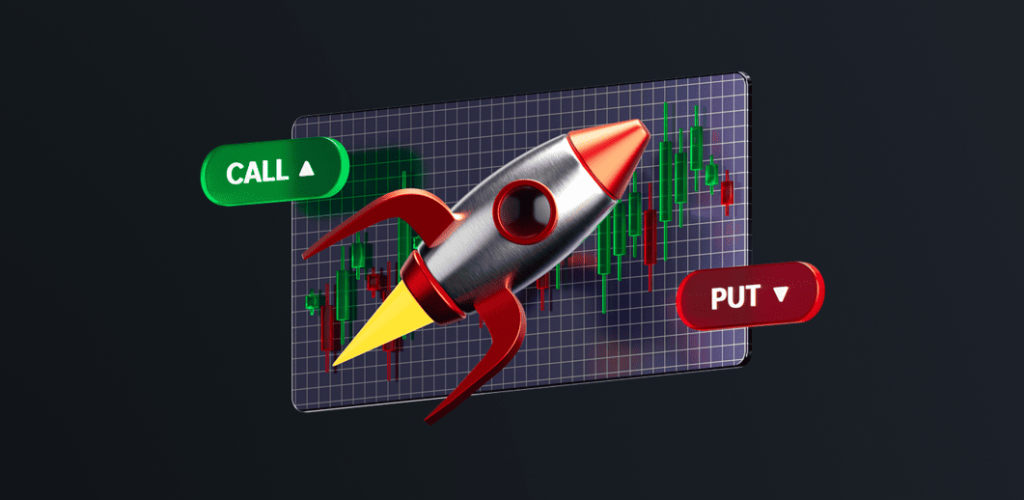
Что такое копи-трейдинг? Определение и обзор
В статье
Понимание копи-трейдинга
Копирование сделок подразумевает автоматическое копирование открытых позиций других трейдеров. Вместо того, чтобы каждый копировщик самостоятельно анализировал рынок и исполнял сделки, он может использовать работу опытных трейдеров и копировать сделки, открытые на поддерживаемых платформах. Копирование сделок осуществляется с помощью автоматизированных процессов, интегрированных в платформы для копирования сделок.
Копи-трейдинг сравнивают или считают синонимом двух других распространённых торговых операций: социальной торговли и зеркальной торговли. Уяснение этих различий поможет понять копи-трейдинг и отличить его от других видов торговли.
Копировальный трейдинг против социального трейдинга
Копирование сделок подразумевает автоматическое копирование дискреционных сделок, совершаемых другими трейдерами на поддерживаемых платформах. Репликация выполняется интегрированными автоматизированными процессами с использованием параметров, заданных копировщиком, таких как процент распределения. Сделки синхронно копируются на счета копировщиков.
Социальный трейдинг, с другой стороны, объединяет трейдеров через дискуссионные платформы, но без автоматического копирования сделок. Трейдеры делятся анализом рынка, стратегиями и планируемыми сделками, которые другие трейдеры могут исполнить вручную по своему усмотрению. Обсуждение сосредоточено на сотрудничестве, а не на прямом копировании сделок, и ордера остаются на усмотрение каждого и зависят от его исполнения.
Сходства
- Оба варианта предполагают использование знаний других трейдеров.
- Трейдеры могут потенциально получить доступ к новым возможностям
- Трейдеры могут учиться у опытных коллег в общих сетях
Различия
- Копировальный трейдинг осуществляет синхронное автоматическое дублирование реальных сделок.
- Социальная торговля сохраняет свободу действий при выполнении заказов за счет ручного исполнения
- Копировальный трейдинг копирует позиции, в то время как социальный трейдинг делает акцент на обсуждении, а не на копировании.
- Социальная торговля основана на индивидуальном усмотрении при размещении ордеров, а не на автоматическом копировании позиций.
- Копировальный трейдинг — это пассивное участие посредством копирования, тогда как социальная торговля делает акцент на активном взаимодействии и сотрудничестве, требующих ручного участия.
- Ордера по-прежнему зависят от индивидуального усмотрения и исполнения в случае социальной торговли, но синхронная репликация в случае копировальной торговли.
Зеркальная торговля против копировальной торговли
Зеркальная торговля подразумевает автоматическое воспроизведение заранее запрограммированных количественных алгоритмических стратегий. Эти стратегии могут быть результатом агрегации данных от многих профессиональных трейдеров. Для копирования копируются целые автоматизированные программы, а не отдельные сделки. Это обеспечивает диверсификацию между множеством систематических сделок.
В то время как при копировании сделок копировщики могут выборочно отслеживать нескольких трейдеров с разными стилями. Вместо целых пакетов, анализируются и копируются отдельные сделки. Копировщики имеют возможность выбора среди трейдеров и настраивают параметры риска для каждого из них.
You may also like

Сходства
- Оба варианта предполагают автоматическое дублирование сделок.
- Обеспечить пассивное участие, используя работу других
- Разрешить диверсификацию или навыки, выходящие за рамки собственных возможностей
Различия
- Копировальная торговля воспроизводит дискреционные решения, одновременно зеркально дублируя количественные алгоритмы.
- Зеркальная торговля осуществляется на основе единых программ, а не избирательно среди разных трейдеров.
- Копировальная торговля позволяет настраивать контроль рисков для каждого трейдера отдельно, а не отслеживать общую стратегию.
- Зеркальная торговля обеспечивает диверсификацию за счет комплексных стратегий, а не избирательности среди отдельных трейдеров.
- Копировальная торговля сохраняет гибкость в отличие от абсолютной приверженности отдельным негибким программам в зеркальной торговле.
Как работает копи-трейдинг?
- Социальные торговые платформы и сети — Копирование сделок осуществляется через специализированные платформы и сети социальной торговли, объединяющие отдельных трейдеров. Трейдеры могут публично делиться сделками друг друга и анонимно копировать их благодаря интегрированной инфраструктуре этих платформ.
- Трансляция и копирование торгов — Когда один трейдер открывает новую позицию на поддерживаемой платформе, исполнение сделки автоматически транслируется в его публичный профиль. Другие трейдеры могут автоматически скопировать эту сделку, интегрировав функции копирования платформы в свои аккаунты.
- Настройка параметров, таких как процент распределения — Копировщики могут настраивать копирование позиций, устанавливая такие параметры, как процент распределения, лимиты риска и фильтры. Например, копировщик может выделить 10% своего счёта для автоматического копирования позиций трейдера. Это позволяет копировать часть сделок другого трейдера, пропорционально подстраиваясь под свой уровень риска.
Как правило, поддерживаемые сторонние платформы связывают трейдеров и обеспечивают дискреционное копирование позиций. Сделки синхронно копируются между счетами с помощью широковещательных обновлений и интегрированных функций. Копировщики настраивают экспозицию с помощью таких настроек, как целевые распределения, чтобы самостоятельно управлять персонализированными рисками, связанными с автоматическим копированием. Это обеспечивает автоматическое участие и в то же время предоставляет возможность каждому пользователю самостоятельно контролировать копирование и экспозицию.
Механизмы копирования сделок в криптовалюте
Криптовалюты значительно выросли как класс торгуемых активов. Учитывая их техническую природу, опытные криптовалютные трейдеры обладают значительными навыками, ценными для копирования сделок. Использование таких знаний обеспечивает доступ к информации, избавляя от необходимости самостоятельно осваивать новые волатильно растущие рынки, требующие от копировщиков определённых навыков. Поэтому платформы отдают приоритет включению криптовалют.
Платформы для копирования сделок включают в свой интегрированный охват рынка ведущие криптовалютные биржи и активы. Трейдеры могут выборочно отслеживать сделки других трейдеров, имеющих особый опыт работы на этих рынках. Копируемые сделки автоматически зеркалируются, как длинные, так и короткие, по основным криптовалютам. Фильтры платформы помогают копировщикам находить специалистов, демонстрирующих ценные знания рынка.
Трейдер может открыть короткую позицию по Ethereum, увидев технические признаки формирования разворота тренда. Копировщики одновременно копируют эту сделку. Благодаря волатильности копируемая сделка гарантирует получение результатов анализа, не требуя от копировщиков их собственной интерпретации. В связи с технологическими рисками по-прежнему рекомендуется использовать узкие индивидуальные стоп-лоссы.
Технические факторы, такие как индикаторы импульса, потоки ордеров и графические модели, приобретают повышенное значение при определении времени выхода на рынок криптовалюты, учитывая их высокую изменчивость. Несмотря на автоматическое зеркалирование, копировщики по-прежнему самостоятельно настраивают размер позиции и узкие стоп-лоссы. управлять рисками соразмерно их толерантности к колебаниям рынка криптовалют.
Плюсы и минусы копи-трейдинга
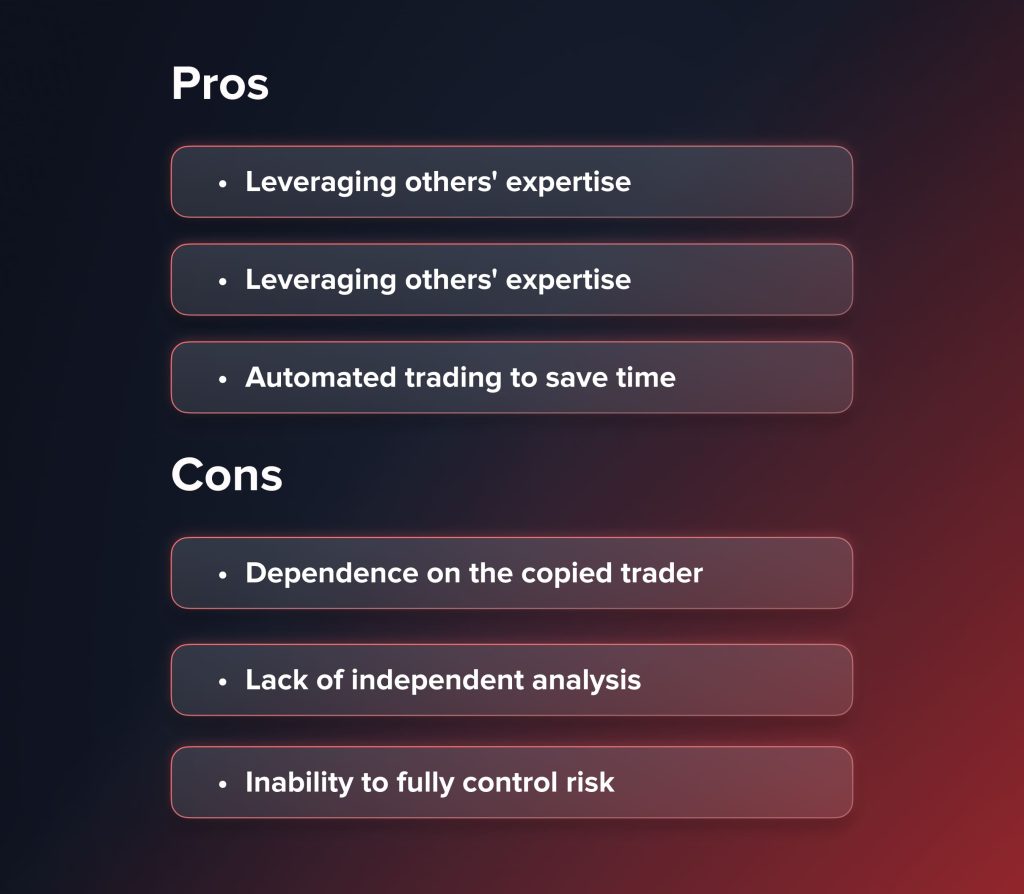
Плюсы
- Использование опыта других — Выборочно копируя опытных трейдеров, копировщики могут воспользоваться обширными знаниями рынка, отточенными навыками и обучением других, не требуя при этом от себя аналогичного опыта. Это даёт доступ к знаниям, требующим значительного времени для разработки.
- Автоматизированная торговля для экономии времени — Копирование заранее выполненного анализа и сделок освобождает копировщиков от необходимости постоянно изучать рынки и самостоятельно управлять позициями. Это обеспечивает гибкость для тех, кому нужна свобода от постоянного активного участия, необходимого для индивидуальной торговли.
- Возможности обучения — Пассивно наблюдая за копируемыми сделками, обоснованиями и результатами работы, копировщики могут постепенно развивать дополнительные навыки и точки зрения, чтобы в конечном итоге снизить зависимость от копирования и риски.
Минусы
- Зависимость от копируемого трейдера — Поскольку результаты напрямую зависят от выбора другого человека, копировщики становятся все более зависимыми, предполагая определенную степень сильных сторон, но также и уязвимостей копируемого трейдера.
- Отсутствие независимого анализа — Отказ от дискреционных полномочий требует признания потери способности самостоятельно обдумывать и подвергать сомнению решения или менять подходы, поскольку в противном случае это было бы обусловлено личным суждением. Копировщики должны принять полный контроль других над принимаемыми решениями и рисками.
- Неспособность полностью контролировать риск — Настраивая такие параметры, как кредитное плечо и стоп-лоссы, копировщики не могут самостоятельно маневрировать, избегая систематических рисков, полностью формируя портфели исключительно по чужим указаниям. Они подчиняются действиям посредника.
Оптимизируя рабочие процессы, копировщики должны реалистично взвешивать возможность пассивной уступки и принятия зависимостей, чтобы использовать усилия других. Это гарантирует сбалансированную свободу действий, а не откровенный автоматизм. Индивидуальная осмотрительность по-прежнему применима к выбору платформ и трейдеров.
Прибыльность копирования сделок
Факторы, определяющие рентабельность
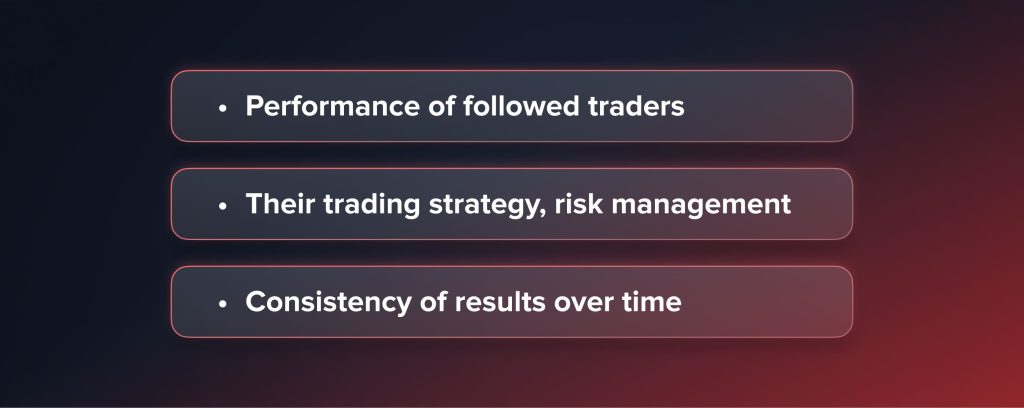
- Результаты отслеживаемых трейдеров — Результаты работы копировщиков напрямую зависят от успеха других, поскольку только копирование решений определяет прибыльность. Значительное количество времени, затраченного на проверку навыков и документирование стратегий и результатов, укрепляет надёжность.
- Их торговая стратегия, управление рисками — Методология, отношение и реакция трейдеров на отклонения также влияют на надежность. Консервативное управление капиталом, использовать и снижение помогает поддерживать применимость производительности в изменяющихся условиях.
- Постоянство результатов с течением времени — Документированные долгосрочные достижения, основанные на дисциплине и преодолении различных обстоятельств, подтверждают наличие навыков, выходящих за рамки конкретных условий. Последовательность обеспечивает возможность воспроизведения портфелей, в отличие от выпадающих, неустойчивых результатов.
Риски, которые следует учитывать
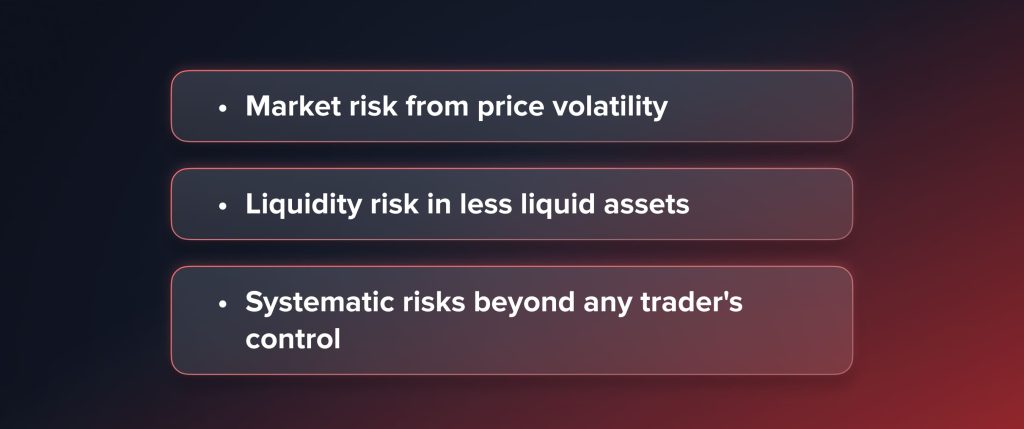
- Рыночный риск от волатильности цен — Любое участие в рынке подразумевает подверженность непредсказуемым колебаниям цен, не зависящим от навыков. Копировщики терпят волатильность, присущую выбору активов, выбранных отслеживаемыми трейдерами.
- Риск ликвидности в менее ликвидных активах — Неликвидные опционы ограничивают гибкость, в то время как высокие объёмы торгов облегчают позиционирование и контроль падения. Копировщики учитывают типичную ликвидность выбранных трейдерами инструментов.
- Систематические риски, находящиеся вне контроля любого трейдера — Макрошоки, подобные «чёрным лебедям», не поддаются расчётам. Поэтому копировщики диверсифицируют свои вложения среди нескольких выдающихся трейдеров, а не полагаются полностью на одного, чтобы избежать непредвиденного кризиса.
При тщательном отборе явно превосходных трейдеров, сохраняющих свою эффективность в различных условиях, прибыльность копи-трейдинга становится реальной. Хотя прошлые результаты не гарантируют непрерывности, документально подтвержденное мастерство и устойчивость расширяют возможности при выборе трейдеров, способных обеспечить надежность. Однако индивидуальное управление рисками остается жизненно важным.
Как начать копи-трейдинг
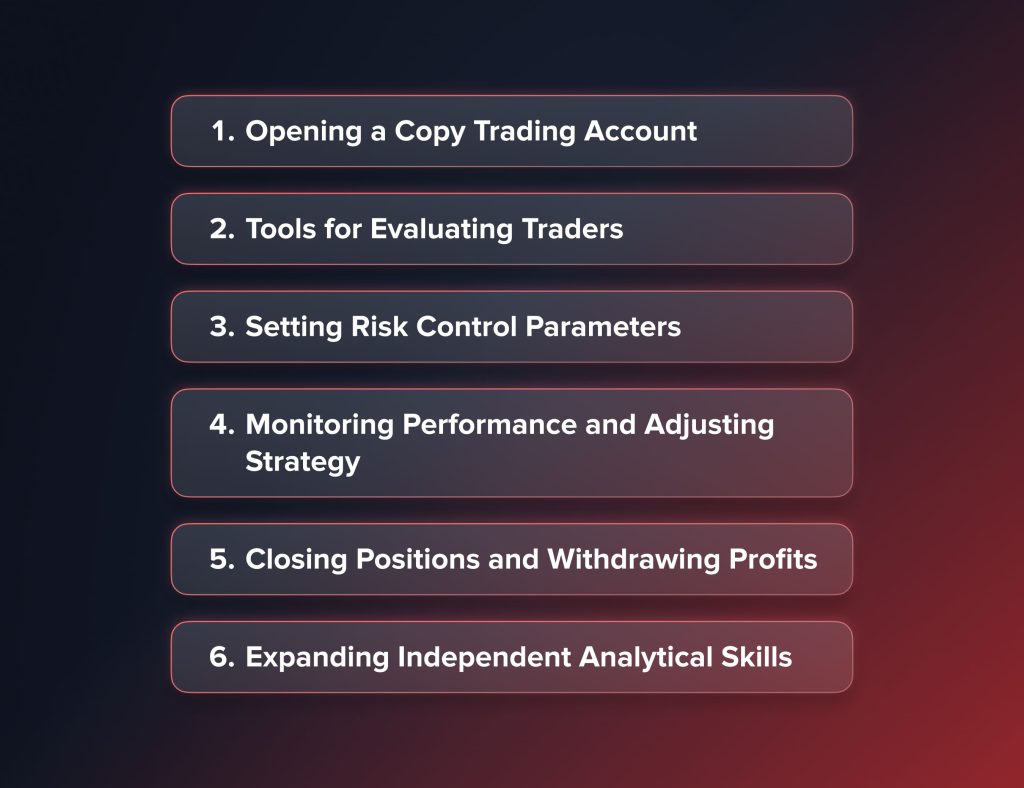
Открытие счета для копирования сделок
Начиная копи-трейдинг, первым шагом будет открытие счёта на проверенной платформе. При выборе платформы следует учитывать несколько факторов. Ищите ту, которая работает несколько лет и имеет большое количество активных трейдеров и средств под управлением, поскольку это свидетельствует о стабильности. Изучите платформы, почитав отзывы трейдеров и крипто-изданий.
Убедитесь, что платформа предлагает те рынки, которыми вы хотите торговать, например, акции, Форекс, криптовалюты и т. д. Также важно наличие поддержки пополнения и вывода средств с помощью распространённых способов оплаты, таких как дебетовые/кредитные карты и банковские переводы. Большинство надёжных платформ требуют подтверждения личности в соответствии с нормативными требованиями. Внимательно ознакомьтесь со всеми условиями перед регистрацией и пополнением счёта.
Инструменты для оценки трейдеров
После регистрации следующим ключевым шагом станет поиск опытных трейдеров для копирования. Оценка важна для отсеивания неэффективных трейдеров и минимизации рисков. Платформы обычно предоставляют различные показатели эффективности для оценки трейдеров.
Некоторые важные показатели, которые следует учитывать, включают фактор прибыли, который показывает доходность с поправкой на риск, историю торговли, желательно длиннее 1-2 лет, чтобы увидеть эффективность в течение рыночных циклов, максимальную просадку, указывающую на самую большую полосу убытков, среднюю доходность инвестиций, общую полученную прибыль и соотношение риска и доходности, показывающее прибыль против убытков.
Вы также можете ознакомиться с описанием трейдерами своего стиля торговли, стратегии, опыта и подхода к управлению рисками. Параметры фильтрации позволяют отбирать трейдеров, специализирующихся на выбранных вами рынках, таймфреймах и инструментах, чтобы обеспечить их соответствие вашим требованиям.
Установка параметров контроля рисков
Перед копированием сделок настройте различные параметры на платформе, чтобы самостоятельно управлять рисками, связанными с автоматической торговлей. Ключевые параметры включают общий бюджет или процент от вашего счёта, выделяемый трейдеру, максимальный размер риска на сделку в долларах или процентах, а также уровни стоп-лосса или трейлинг-стопа, автоматически закрывающие убыточные позиции.
Вы также можете настроить оповещения, чтобы получать уведомления об открытых позициях, крупных прибылях/убытках и других важных действиях. Различные протоколы оповещений помогают более тщательно отслеживать копируемые сделки. Кредитное плечо, если оно доступно, следует использовать разумно, учитывая историческую волатильность копируемых позиций.
Параметры риска должны пропорционально ограничивать риск просадки в соответствии с вашей толерантностью к риску и целями портфеля. Эти элементы управления позволяют независимо управлять рисками, автоматически копируя сделки других.
You may also like

Мониторинг эффективности и корректировка стратегии
После включения функции копирования сигналов или сделок внимательно отслеживайте первоначальные результаты ежедневно или еженедельно, сравнивая их с ожиданиями. Регулярная переоценка позволит обеспечить постоянное превосходство над ожиданиями.
Аналитика платформы помогает анализировать прибыльность, эффективность контроля рисков, статистику доходности и периоды просадки скопированных сделок. На основе мониторинга корректируйте участие по мере необходимости, изменяя распределение средств по отдельным трейдерам, отслеживая количество сделок, ужесточая стоп-лоссы или увеличивая кредитное плечо.
Переоценка скопированных трейдеров позволяет выявить неэффективных трейдеров для замены. Эта постоянная оперативность сохраняет актуальность в условиях меняющихся условий. Со временем дополняйте ручные записи сделок выборочным копированием, дополняя уже существующий анализ. Постепенно увеличивайте объем самостоятельной работы по сравнению с опорой на других, чтобы сохранить преимущества в долгосрочной перспективе.
Закрытие позиций и вывод прибыли
По мере достижения целей закрывайте открытые позиции вручную, если это требуется в соответствии с тактическими изменениями. Платформа также автоматически закрывает позиции по назначенным стоп-уровням. Накопленную прибыль можно безопасно вывести на привязанный банковский счёт или кошелёк.
Частичное извлечение данных позволяет поддерживать текущую активность копирования по мере необходимости. Осмотрительные обзоры отслеживают долгосрочную эффективность и сохранность капитала, чтобы максимизировать выгоду, одновременно снижая риски, связанные с зависимостью от чужого опыта при определении результатов.
Расширение независимых аналитических навыков
В то время как копирование сделок оптимизирует участие в рынке, постепенно уделяйте больше времени ручному анализу предпочтительных активов, используя предоставленные инструменты платформы и внешние источники. Развивайте независимую точку зрения на рынок, оценивая идеи копируемых трейдеров.
Кроме того, необходимо улучшить процедуры комплексной проверки трейдеров, изучая более детальную информацию о результатах, подверженности рискам, поведении при просадке и надежности стратегии в условиях меняющихся рыночных зон. Более строгий отбор трейдеров напрямую отражается в копируемой активности и повышает её надёжность.
Проходя через эти систематические этапы, охватывающие ключевые процессы, и постоянно совершенствуя стратегические подходы и подходы к управлению рисками, трейдеры разрабатывают жизнеспособную долгосрочную методологию копирования сделок, одновременно расширяя свои аналитические навыки. Такой баланс оптимизирует преимущества, одновременно сдерживая присущие им риски и зависимости с течением времени.
Разработка стратегии копирования сделок
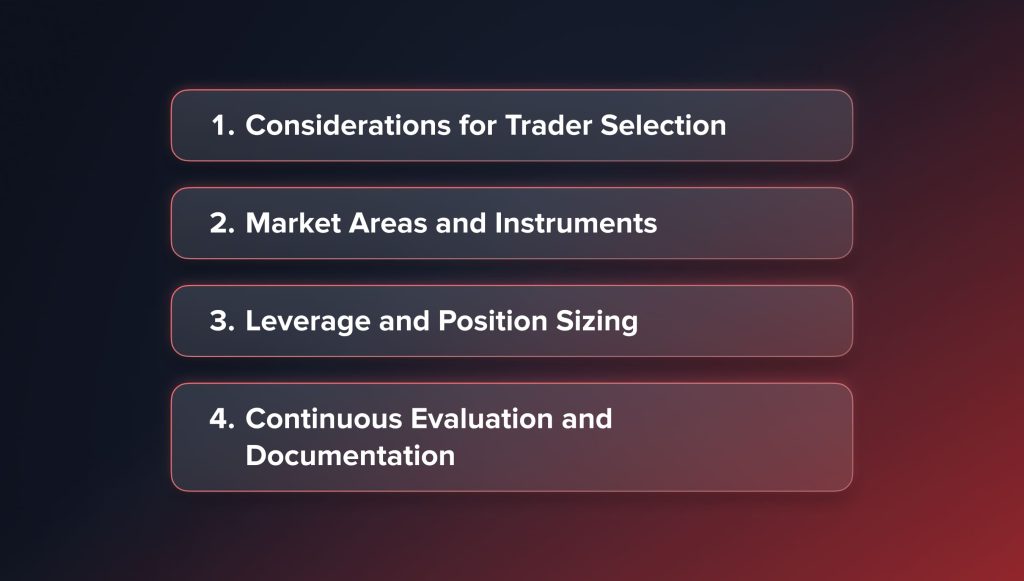
Факторы, которые следует учитывать при выборе трейдера
Тщательная оценка потенциальных трейдеров для копирования имеет решающее значение для успеха. Рассматривайте трейдеров с историей не менее 2–3 лет успешной торговли в различных рыночных условиях. Анализируйте показатели прибыльности, такие как годовая доходность, коэффициент Шарпа, фактор прибыли и максимальная просадка, чтобы оценить доходность с поправкой на риск.
Изучите ежемесячный и годовой рост доходности с течением времени, чтобы выявить постоянство и выбросы, основанные на краткосрочных показателях. Проверьте средний размер выигрышной и проигрышной сделки, чтобы обеспечить сбалансированное по риску вознаграждение. Изучите описание торгового подхода, стиля управления рисками, опыта и адаптивности.
Диверсификация среди нескольких ведущих специалистов с разными, но взаимодополняющими стилями работы на разных рынках снижает зависимость от прогнозов каждого отдельного человека. Выявляйте специалистов, преуспевающих в областях, совмещая личные интересы, для лучшего понимания.
Рассмотрите возможность проверки личности и полномочий потенциальных трейдеров, где это возможно, чтобы оценить их легитимность. Периодически пересматривайте выбор, чтобы убедиться в постоянном соответствии проанализированным критериям.
Рыночные зоны и инструменты
Изначально сосредоточьтесь на копировании на наиболее знакомых рынках, требующих минимального дополнительного исследования. Например, на основных валютных парах или фондовых индексах для тех, кто более разбирается в макроэкономике, чем в криптовалютах или менее популярных активах. Ограничение масштаба помогает лучше понять обоснования других в отношении разумного контроля рисков.
Отдавайте приоритет инструментам с достаточной ликвидностью, избегая зависимости от узкоспециализированных активов, уязвимых к неэффективному ценообразованию. Дополняйте выбор скопированных позиций ручными сделками в недостаточно представленных областях, развивая навыки.
Постепенно расширяйте сферу применения, включая менее знакомые дисциплины по мере накопления знаний, но избегайте слишком широкого диверсификации на начальном этапе, что может привести к снижению контроля. Посвятите исследования изучению уровня подготовки специалистов, оценивая их способности в предпочтительных областях, что повышает их ценность. Уникальность предпочтений, основанная на опыте, минимизирует дублирование личных сильных сторон для оптимизации обучения.
Кредитное плечо и размер позиции
Лично установите максимальный размер кредитного плеча ниже исторически подтвержденного устойчивого уровня для реплицируемых трейдеров. Рассмотрите возможность первоначального копирования позиций без дополнительного кредитного плеча, пока не убедитесь в совместимости с различными обстоятельствами.
Ограничьте объёмы кредитного плеча, составляющие разумную долю от общего объёма, избегая чрезмерной зависимости от любого отдельного источника копирования. Систематически проверяйте и доказывайте целесообразность увеличения кредитного плеча по мере роста навыков и возможностей мониторинга. Отдельно настраиваемый размер кредита обеспечивает разумное распределение риска между отслеживаемыми трейдерами независимо от применяемой ими маржи.
Создайте диверсифицированный портфель, дополнив автоматизированные позиции независимыми ручными инструментами, выбранными с консервативной позицией. Такой баланс предотвращает чрезмерное усиление любого единичного скопированного риска, сохраняя при этом гибкость.
Непрерывная оценка и документирование
Пересматривайте свои решения, реагируя на изменения рынка, используя инструменты платформы, анализирующие подробные показатели эффективности, выходящие за рамки рекламы. Оценивайте внутримесячные или еженедельные колебания в сравнении с долгосрочной динамикой. Анализируйте необъяснимые падения, чтобы подтвердить устойчивость.
Документируйте эволюцию взглядов, основанную на сравнении неудачных и успешных вариантов, улучшая будущие оценки. Организуйте скопированные обсуждения, стимулирующие самостоятельные выводы. Постепенно отказывайтесь от опоры на внешние сигналы, сосредоточившись на ручном исследовании для выявления воспроизводимых закономерностей. Вопросы, составленные в виде заметок, создают возможности для самостоятельного обучения.
Корректируйте скопированные риски, обеспечивая совместимость с учетом отклонений. Извлекайте максимум знаний из процесса, сохраняя гибкий, но осмотрительный подход, исключающий чрезмерную зависимость от решений других лиц, регулирующих портфели.
Скрупулезное, адаптивное и всестороннее выполнение каждой основной дисциплины способствует построению жизнеспособной долгосрочной методологии копирования сделок, способствующей саморазвитию наряду с профессиональным руководством.
Заключительные мысли
В заключение, разработка комплексной и сбалансированной стратегии копи-трейдинга требует тщательной оценки трейдеров, фокусировки на совместимых рынках, самостоятельного управления рисками и постоянного совершенствования подхода. Дисциплинированная методология, сочетающая преимущества автоматизации с навыками независимого анализа, может помочь оптимизировать результаты, одновременно снижая неотъемлемые риски и зависимости, связанные с опорой исключительно на чужие торговые решения.
Обновлено:
19 декабря 2024 г.




